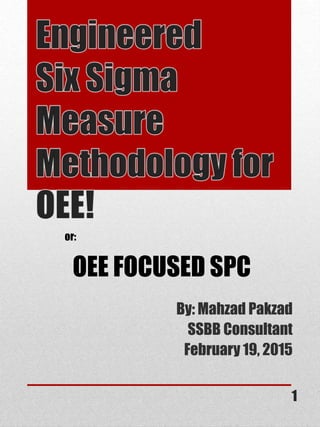Engineering
- 1. By: Mahzad Pakzad SSBB Consultant February 19, 2015 1 or: OEE FOCUSED SPC
- 2. This presentation is designed to simplify the Six Sigma Methodologies used to support management to apply strategically planned operations management and practical statistical process control tools, in order to Effectively Monitor and Control the Process Equipment and their outputs, and focused on Overall Equipment Effectiveness and SPC Measurements. Main justification for applying the methods suggested here in an actual operations is Cost of Quality, which may not be as important to low end products in todaysâ markets. Cost of Quality not only can be calculated as loss during production (labor + materials), it also needs to be evaluated and priced as loss of sales and even customers to the competitors. Doing it right the first time might look more expensive on paper, at first, however, if the justification is prepared by âExperienced Peopleâ, it can be proven that a well engineered operation that applies innovative solutions to align productsâ designs, processes, and process controls, not only can deliver a more cost effective product, but it could also increase sales by increasing customer loyalty and establishing a brand name that can be âTrusted for Reliability and Qualityâ. 2
- 3. âĒ Expenditures on R & D and Production are Limited based on ROI. âĒ Innovative solutions can justify the expenditure on Advanced Technologies or Methods to improve both Quality & Productivity. âĒ Improved Quality & Productivity can result in âIncreased Salesâ, and enable companies to increase their expenditure on R & D, New Products Development, and New Processes & Production Equipment Development, which in return support more jobs and Improved Economy. âĒ This presentation is a combination of âIndustry Practiced Standardsâ & â30 years of Practicing Proven Advanced Engineering Methods used for Reliable Equipment Design & Developmentâ to justify investment in production for a variety of industries & to increase profit by aligning Customer Needs with Design Specs, Processes, Equipment, & Quality Systems. 3 In a nut shell we want to âApply Methods Engineering to Improve on Effectiveness of Six Sigma Methodologies Overall Equipment Effectiveness, Reliabilityâ, and SPC Measurementâ, used by many industries, by calling the audiencesâAttention and Focus on Developing Measurement Systems based on a Thorough Knowledge of Their Specific Products and Equipment Design Requirements to Deliver Customersâ Requirements Consistently, & Support Increased Sales & Profits Earnings, That Support Economy & Jobs.
- 4. QUALITY SYSTEMS CAN ONLY SUPPORT OTHERS WITHIN ORGANIZATION TO DELIVER CUSTOMERSâ REQUIREMENTS FINISHED GOODS QUALITY CUSTOMER VOICE FINANCE INTERNAL BUSINESS PROCESSES QUALITY SYSTEM COMPANY LEARNING & GROWTH SUPPLIER 4
- 5. OBJECTIVE SUMMARY: Overall Equipment Effectiveness Programs are not processes that could be cookie cut copied. That is why implementing industry standards for OEE, Reliability, and SPC may not prove effective for all. Equipment efficiency depends on equipmentâs ability to handle the productsâ variations per specified requirements for the processing the parts, and control variablesâ limits as required in order to maintain the output consistent. The tuning and or calibration requirements must be pre-determined for a scheduled Preventive Maintenance. For each application these criteria may vary based on: âĒ Built equipment structure, & controls needed to have the ability to deliver reliably; âĒ Processes Speed, Sensitivity and Equipment Accuracy/Precision needed to handle the variation of incoming materials/products, while maintaining a robust output per design spec and quality needs. âĒ Installation and Reliability of Services/Utilities needed. âĒ Effects of Production or Operational Environment on Machinery Performance âĒ Operations / Set-up Training and Adequacy âĒ Preventive Maintenance Requirements / Management 5
- 6. OBJECTIVE SUMMARY Contâd I) SET THE REQUIRED PRODUCTSâ SPECIFICATIONS: First and most important step that many overlook is: âĒ to clarify design specs for parts/media being processed, and identify the required specification limits for outputs and inputs as well. II) DETERMINE PRODUCTION & PROCESS REQUIREMENTS: âĒ by collaboration between Manufacturing Engineer, Production (PM + Operations), and Quality Team, Project Manager (May be Mfg. Eng.) âĒ to develop a Realistically Practical and Reliable quality system for monitoring and controlling the processes/equipment and their outputs. âĒ This includes having appropriate SPC tools to monitor products and processes as needed, & decide if they need to be automatically managed. III) MANAGE DESIGN & DEVELOPMENT OF EQUIPMENT: The Equipment Project Engineer (ME?) must work with equipment Suppliers/ Manufacturers to choose best options for each Specific Application. HINT: For those with existing equipment that have limited capability: âĒ the limitations (inconsistencies due to materials variation, environmental temperature changes,âĶ) must be identified, by tests, DOE,.. âĒ Appropriate measures for monitoring and controlling processes & Products Quality must be set as a Regular Part of Operation, not after the interruptions due to quality issues or machine breakdowns, âĒ then a careful adjustment to standard procedures for production (operations, PM,..) and IE standards, must be made. 6
- 7. JURAN âS HANDBOOK QUOTES: A business process is the logical organization of people, materials, energy, equipment, and information into work activities designed to produce a required end result (product & / or Service). Three principal dimensions for measuring the quality of this process are: âĒ Effectiveness: how well the output meets customer needs âĒ Efficiency: the ability to be effective at least cost. âĒ Adaptability: the ability to remain effective and efficient in the face of change 7
- 8. Equipment Processes Products + Process Design Specifications Quality System 8 QUALITY SYSTEMS MAINLY âĒ SUPPORT & ENFORCE âCORRECTâ DEPLOYMENT OF PRODUCTS, & PROCESSES DESIGN SPECIFICATIONS DEVELOPED BY OTHER BUSINESS UNITS. âĒ KEEP ON SUPPORTING PRODUCT QUALITY BY MONITORING / CONTROLLING LIMITS SET BY DESIGN.
- 9. An Advanced Quality System Monitors and Manages Control of all Designs: DESIGN For x: QUALITY CONTROL MANUFACTURING METHODS CUSTOMER REQUIREMENTS 9 âĒ Design for Manufacturing âĒ Design for Assembly âĒ Design for Service âĒ Design for Cost
- 10. 10










